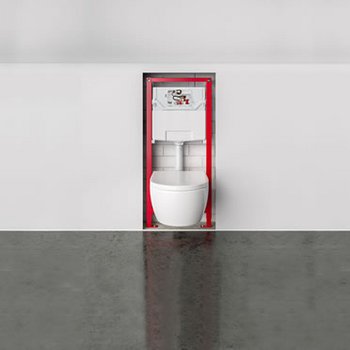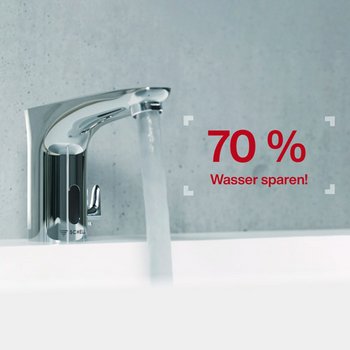Flushing the drinking water system: recommissioning after conversions and renovations
Conversion and renovation work in (semi-)public and commercial buildings can pose a risk to drinking water hygiene in some circumstances. On the one hand, bacteria can propagate to levels harmful to health as a result of water stagnating in the piping. On the other hand, the drinking water installation can become contaminated as a result of building work or the use of contaminated components. Ensuring recommissioning is completed professionally for drinking water installations after renovation work is therefore extremely important. Knowledge of the required steps is not only important for building operators and tradespersons but – in particular – for fit-out planners. This blog post provides you with information about what needs to be considered for recommissioning work, and how drinking water quality can best be protected both during and after renovation projects.
Steps to take for the recommissioning of drinking water systems after interruptions in use
As with anything else intended for human consumption, drinking water is perishable and subject to strict regulations. Even after as little as 72 hours, concentrations of bacteria such as Legionella can rise to critical levels and endanger the health of users. Interruptions in use that last weeks or even months are therefore a serious problem for drinking water hygiene. Details of what constitutes an ‘interruption in use’ and how professional recommissioning should be completed can be found in the set of standards DIN EN 806, DIN 1988 and DVGW W551-3(A).
The steps that apply to recommissioning work after specific periods of time are set out in the following table:
Bear in mind that the ‘acceptance tests’ necessary after an interruption in use lasting more than 4 weeks involve significant extra effort and a longer phase of uncertainty about the installation. This is because the safety of the drinking water installation in terms of Legionella infection is a question that can only be answered after a period of 24 weeks – nearly half a year. Fit-out planners should therefore ensure their tender specifications account for the scope of/work involved in acceptance testing (both time and expenses) – especially in the case of renovations.
If the drinking water installation is separated from the public water mains during very long periods of building work, the steps for recommissioning are the same as the procedure for a new drinking water installation, as per DIN EN 806-4: the drinking water installation is flushed and microbiological acceptance testing must also be performed.
The requirements set out above make it clear that recommissioning after more than four weeks is often associated with considerable effort in terms of personnel, time and money. In contrast, a stagnation flush performed after no more than 72 hours – with the SCHELL SWS Water Management System, for example – does not tie up so many resources and is comparatively easier for building operators. In fact, weighing up the benefits of this approach is mandatory for building operators in the German public sector (cf. AMEV regulations): if a higher level of initial investment can be justified by lower operating costs, then this solution must indeed be selected.
A rule of thumb for tradespersons: have the water tested before renovations
If an interruption in use of up to 4 weeks results from work on the drinking water installation, tradespersons are strongly advised to have the drinking water sampled and sent for microbiological testing beforehand. This testing should be commissioned by the fit-out planner. This is the only way that tradespersons can establish whether or not the installation was contaminated before they started work. After completing their work, tradespersons should also organise acceptance testing using the parameters from VDI 6023 Part 1, Table 1, as well as the Legionella parameter, at the point in time when the building work was accepted. This is important because, in the case of public and commercial buildings, section 31(4) of the German Drinking Water Regulation (TrinkwV) requires building operators to commission Legionella testing by the health authorities after no fewer than 3 months and no later than 12 months. If this test reveals the presence of Legionella, the tradesperson can use the acceptance test results to show that their work was performed correctly.
Protecting against contamination with dry-tested parts
Stagnation is not the only risk to drinking water quality that occurs as a result of conversion and renovation work. Other risks include the dust and dirt produced by construction work, and parts contaminated during the production process. While the first risk can be mitigated by ensuring hygienic working and storage conditions on site, it is the manufacturer who bears responsibility for avoiding the contamination of parts during production. Wherever possible, parts should therefore be dry-tested during the production process. All SCHELL products are dry-tested, and therefore offer an effective level of protection for drinking water against contamination with bacteria that are harmful to health. Some parts, such as safety fittings, have to be calibrated at the factory in the presence of water and therefore cannot be tested dry. In this case, the parts must be tested with sterile water and then protected against potential bacterial contamination. This can be achieved with disinfection steps, for example, and recommendations for handling by tradespersons at the construction site.

![[Translate to English:] [Translate to English:]](/fileadmin/_processed_/1/b/csm_symstemloesungen_e2_thumb_6bca267f26.jpg)























![[Translate to English:] [Translate to English:]](/fileadmin/user_upload/images/menu/menu_service_downloads_broschueren.jpg)








![[Translate to English:] [Translate to English:]](/fileadmin/_processed_/7/7/csm_menu_unternehmen_ueber-schell_awards_f6cec25b1d.jpg)
![[Translate to English:] [Translate to English:]](/fileadmin/_processed_/a/0/csm_menu_unternehmen_ueber-schell_wasser-sparen_41036d2dd9.jpg)












